With a country so vast as Germany, many people often skip over Dresden when planning their European adventurers. Berlin, Munich and Cologne are often the first ones that come to people’s minds. But to me, my favourite city is the often-overlooked Dresden. Dresden was so heavily bombed during WWII that almost nothing remained of the original baroque city. But walking through the town today, you’d never know that. After the war, a vast restoration project took shape to bring the city back to its original nature. So come with us today on a self-guided walking tour of Dresden’s old town and historic centre.

The reconstructions mean that Dresden feels both old and new simultaneously. And it truly is a unique experience for the viewer. This walking tour of Dresden will lead you around some of the city’s most important landmarks in the Historic Old Town. You will learn as you go all about the distinctive architectural styles of the city. And absorb all the wonders Dresden has to offer. This tour doesn’t cover the interiors of the buildings. But if you want to extend your walking tour, feel free to explore the insides. This will add more time, but since the walking tour will take only a day, it is easy to do it all in 48 hours.

- Map of Walking Tour
- Brühl's Terrace
- Dresden School of Fine Arts
- Albertinum
- Sekundogenitur
- Schloßplatz
- The Katholische Hofkirche
- Sächsische Ständehaus
- The Georgentor
- Augustus Bridge
- Theaterplatz
- Semper Opera
- Cafe Schinkelwache
- Zwinger
- Dresden Castle
- Hotel Taschenbergpalais Kempinski
- Procession of Princes
- Stallhof und Langer Gang
- Neumarkt
- Dresden Frauenkirche

Map of Walking Tour
Brühl’s Terrace
You’ll start the tour in Brühl’s Terrace, specifically along the riverside gardens. A perfect time to begin the walk is early in the morning. This way, you can get your feet wet. And your bearings about you before you decide where you might want to spend a little bit more time in the afternoon. We’ll end the tour in a great area to get a bite to eat but if you see somewhere along the way, let your senses guide you.

Brühl’s Terrace was known as the Balcony of Europe. It is an enormous platform stretching along the Elbe River’s shores. Here you’ll see tourists and locals strolling down the promenade and enjoying the fantastic views. The terrace was built as a fort to protect the city from invaders. But in the 19th century, it was transformed into this lovely pedestrian walkway.

Elbe River
From the edge of the garden, you can look out over the Elbe River and across to what is now called Neue Town. The King of Saxony, Augustus II, gave this plot of land to his cabinet master, the Earl of Brühl. Brühl employed the famous landscape architect Johann Christoph Knöffel to create a public garden for the people to go alongside the magnificent ramparts of the terrace.

Dresden School of Fine Arts
The building with then golden-winged creatures along the top and a giant glass dome, known as the Lemon Squeezer, is the Dresden Academy of Fine Arts. Built in 1764, this Art Academy was a workplace and a training ground for influential European artists. On the side of the building facing the Elbe, the names of Pheidias, Iktinos, Praxiteles, Polykleitos, Lysippos, Erwin von Steinbach, Leonardo da Vinci, Michelangelo, Raphael and Dürer are inscribed. On the other side, the motto “DEM VATERLAND ZU ZIER UND EHR” or “For the Honour and Adornment of the Fatherland .”Instead of angels, it is interesting to notice that the golden figures on the roof are Phemes, creatures from Greek mythology. These creatures are the physical personifications of fame. What a perfect reference for a place which houses artists.

Albertinum
The sandstone-clad Renaissance Revival building along the terrace is the Albertinum. This building houses Dresden’s modern art masterpieces. The Albertinum was once the old city armoury, built in 1559 inside the old fortifications. After the fort had been destroyed to make room for a public terrace, the armoury had to be converted. In 1884 it was renovated to become a new city museum. Carl Adolf Canzler built the museum in the Renaissance Revival style featuring a balanced, symmetrical facade, a small pitched roof, ornated columns and decorative arches above doors. The works of art on display inside blend both paintings and sculptures. Together they cover around 200 years of modern art. If you’re a fan of Rodin, this is a great place to see some of his best works in a relatively relaxed setting.

Sekundogenitur
If you’re feeling like something to drink, you have to stop and grab a coffee at the cafe Vis a vis which belongs to the Hotel Hilton. This elegant, neo-baroque building, topped with a bright turquoise copper roof, was once the Secundogenitur, the German House of Parliament. It was originally built in 1897 and also used as the State Library. At one time, this building contained more than 60,000 books and manuscripts. The Hilton owns the building and is an excellent choice for anyone looking to stay somewhere historic with one of the best views in Dresden.

Schloßplatz
The Schloßplatz, or Palace Square, is the main intersection in the old town district. It is named the Palace Square since the former royal residence sits right on the edge of the plaza. A balcony down from the residence looks out over the square below so that the royals can take a peek at the people going about their daily lives. Like most other parts of the old city, the original 15th-century architecture was destroyed during WWII bombings. But thanks to the efforts of many, the buildings have been laboriously restored to their original historical designs.
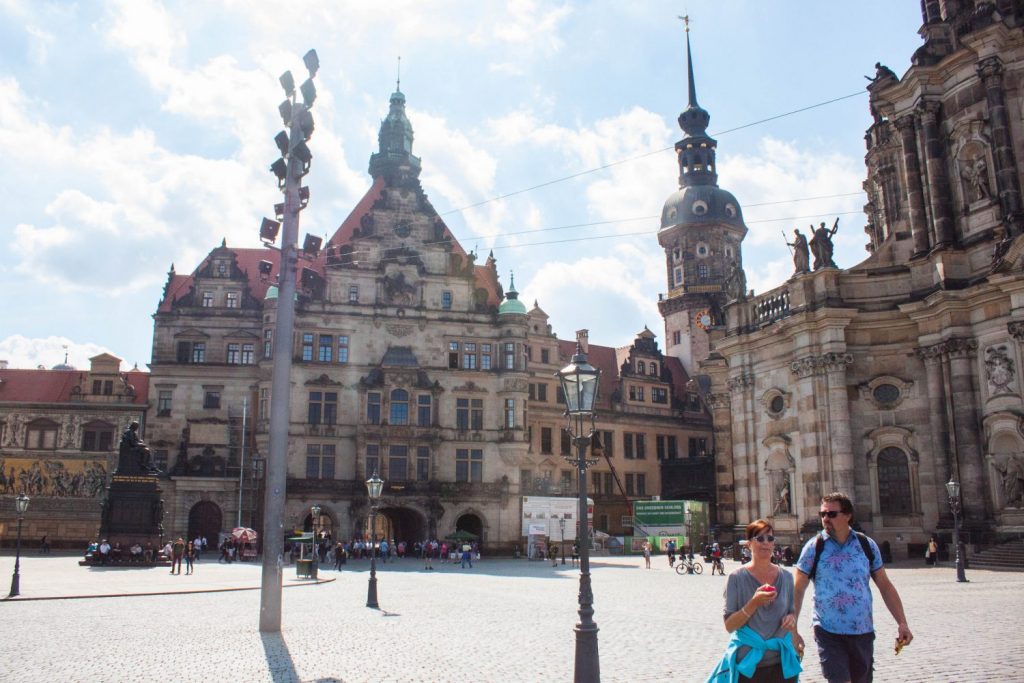
The Katholische Hofkirche
The Katholische Hofkirche, or Cathedral of the Holy Trinity, was the center of Catholicism in Dresden in the early 17th century. The church was commissioned by Augustus III after his father had previously built a Protestant church on the other side of town. Augustus III wanted a place for his Catholic subjects. This church now houses the crypts of some of the most powerful people from Saxon history.

The original church was built in 1738 and completed in 1755. The church’s inside and outside have been restored since the bombing. You can still make out parts of the old church as the colour of the original sandstone has turned black due to the natural oxidization of the stone. The shape of the church is a giant oval fronted with an intricate facade complete with a bell tower and copper onion domes. Surrounding the church are dozens of balustrades from which seventy-eight statues of historical and biblical figures look out over the city.
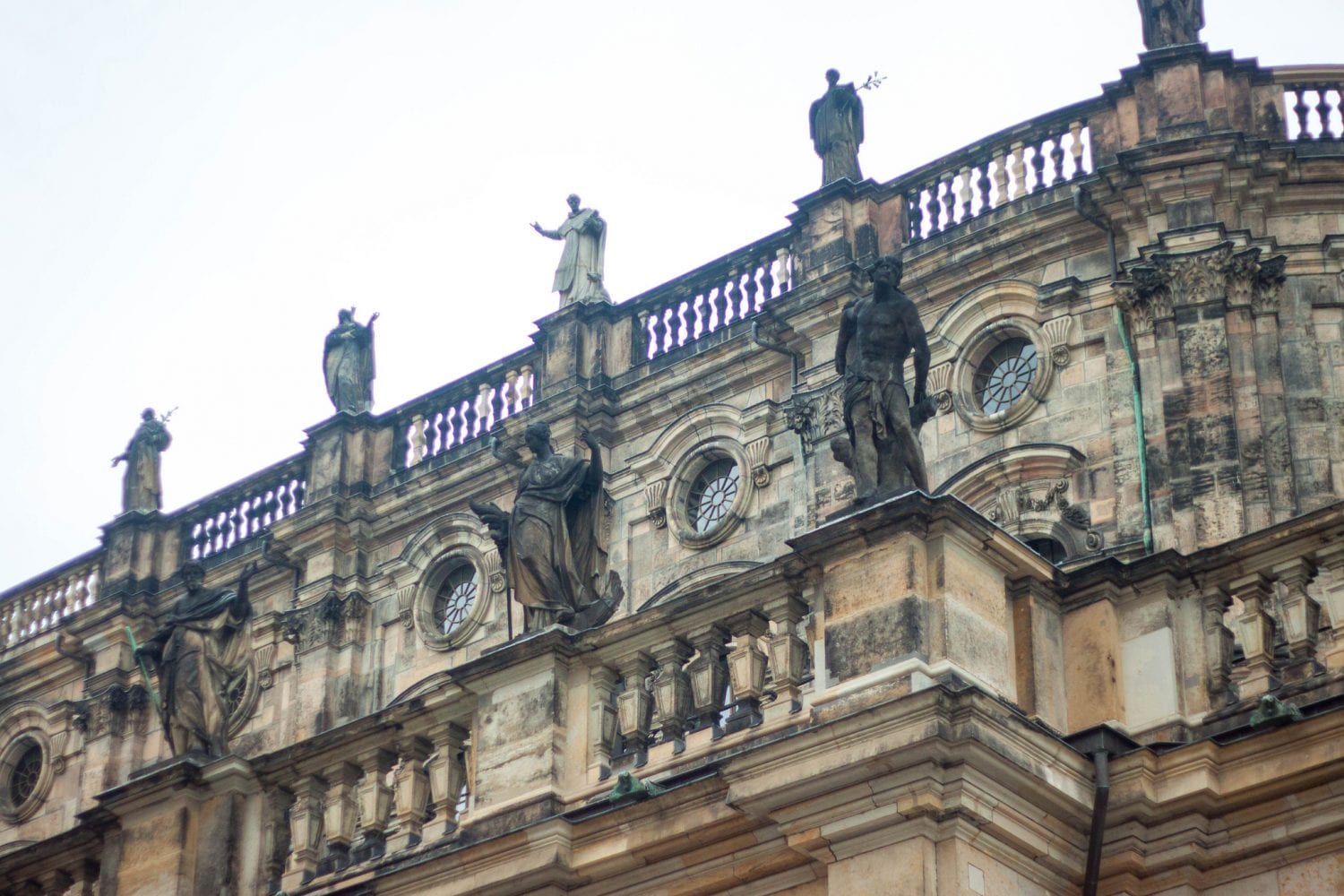
Sächsische Ständehaus
The Saxon Ständehaus is the former Parliament building. It is now the headquarters of the High Regional Court of Dresden and the State Office for Monument Preservation of Saxony.

The Georgentor
The Georgentor or Georgenbau is my favourite building on the square. It is the first building built in Renaissance and neo-renaissance style in Dresden. The Georgentor was originally constructed to serve as an entrance and exit for people coming to and from the city, so the design had to be of the utmost elegance and grace. As well as show off the wealth and status of this great city.

The facade of the building is covered in the religious subject matter. The figures of life and death guard the entrance and above them the motto “Per invidia Diaboli Mors Intravit In Orbs” (through the devil’s envy death entered into the world) is etched into the stone.

Augustus Bridge
The Augustus Bridge opposite the square leads in and out of the Neue Town and crosses the Elbe. The bridge is the oldest in the city, built between 1907 and 1910. There has always been a bridge erected in this position since the 12th century., but time and innovations have caused different bridges to be built and subsequently torn down over time. This structure is built in sandstone with nine arches and wide openings for river traffic.

Across the square, there are horse-drawn carriage rides on offer. And as much as these are a cheesy way of getting about town, if you have the money to spend, the almost museum-like historical recreations of Dresden’s Old Town are the best complement for a horse-drawn carriage ride.
Theaterplatz
Walking down the pathway to the left of the Catholic Church, you will exit out into the Theaterplatz or Theatre Square. In the centre, looming high above you, is the equestrian statue of Saxon King Johann, built in 1889 by Johannes Schilling. King John ruled over Saxony from 1854 – 1873. In 1871 he fought alongside Germany to take the Prussian empire in a long-fought but successful battle. The King loved literature and the arts and as such, his statue being housed beside the Opera house seems fitting.

Semper Opera
The largest building and most important here is the Semper Opera house. The Saxon State Opera is home to a large concert hall, the State Orchestra and the Semperoper Ballet. The Semper Opera House, once known as the Hoftheater, was first built in 1841, but that is not the building you see today. Created by architect Gottfried Semper, the building is now named, in an early Renaissance style, complete with baroque and Corinthian pillars. This was once regarded as one of the most beautiful buildings in European history. But in 1869, a devastating fire broke out, turning the Opera House into rubble. The Opera house has become a cultural centre for the city, and its people rebuilt it immediately.

Manfred Semper
The original architect’s son, Manfred Semper, took over building the new Opera house using the plans from his father and some new Neo-Renaissance styles to update it for the modern era. This building was completed in 1878 but would not stand for long. In 1945, the bombing of Dresden destroyed most of the Opera house, and it had to be, once again, rebuilt.
Today’s building is almost an exact replica of the one that Semper’s son built in 1878 but with the addition of modern machinery. The Semperoper reopened with the opera performed just before the building’s destruction in 1945, Carl Maria von Weber‘s Der Freischütz. The opera house has been home to some of the biggest names in the business, including Richard Wagner and Richard Strauss.

Cafe Schinkelwache
If it’s time to grab something to eat, stop into Cafe Schinkelwache. The Café Schinkelwache is a classic coffee house known for its traditional desserts. The restaurant’s walls are covered with antiques and vintage ephemera. They make you feel like this was the same place people would have visited after the opera hundreds of years ago.

Zwinger
Pass through the large arched gates opposite the Semper Operainto The Zwinger. The Zwinger is one of those historic buildings so seamlessly incorporated into the city’s fabric that it’s almost impossible to imagine the city without it. Yes, it is also a popular tourist destination, but the people who live and work in Dresden don’t treat it as a place just for visitors. For them, it’s a commuter pathway, a meeting spot for lunch, a place to sneak away with your date for a midnight kiss, and even a great place for a jog.

Germany’s Versaille
The Zwinger is to this day one of the most incredible baroque buildings in Germany. It was built for Augustus II the Strong. After returning from a grand tour through France and Italy in 1687, he explored King Louis XIV’s new court of Versailles. He was eager to create a similar elaborate palace for himself in his hometown of Dresden. The word ‘Zwinger’ comes from the medieval German term for a fortress wall which protects a city. Archaeologists discovered, that in the 12th century, the city’s fortification walls were once in this exact location.

The Zwinger was built in the late baroque style called ‘Rococo’ by designer Pöppelmann in 1710-1728. The Rococo style embraced curves and elaborate ornaments but amped up the drama. Rococo added a sense of play to the designs. Rococo designers felt that architecture should have a sense of motion and used dramatic curves, making the viewer feel as though the building was alive. The Rococo style loved to emphasize piety. Plants and vines are featured prominently, carved into many parts of the Zwinger.

Once inside the Zwinger, you can visit one of their three incredible galleries. The Old Masters Picture Gallery contains an exquisitely curated collection of some of the best European Old Masters. The Dresden Porcelain Collection is a collection of Asian and Meissen porcelain designs from the 16th-19th century. The Mathematical and Physical Instruments Gallery has some of the most interesting scientific instruments that helped astrologists from the 16th century discover the universe’s secrets.
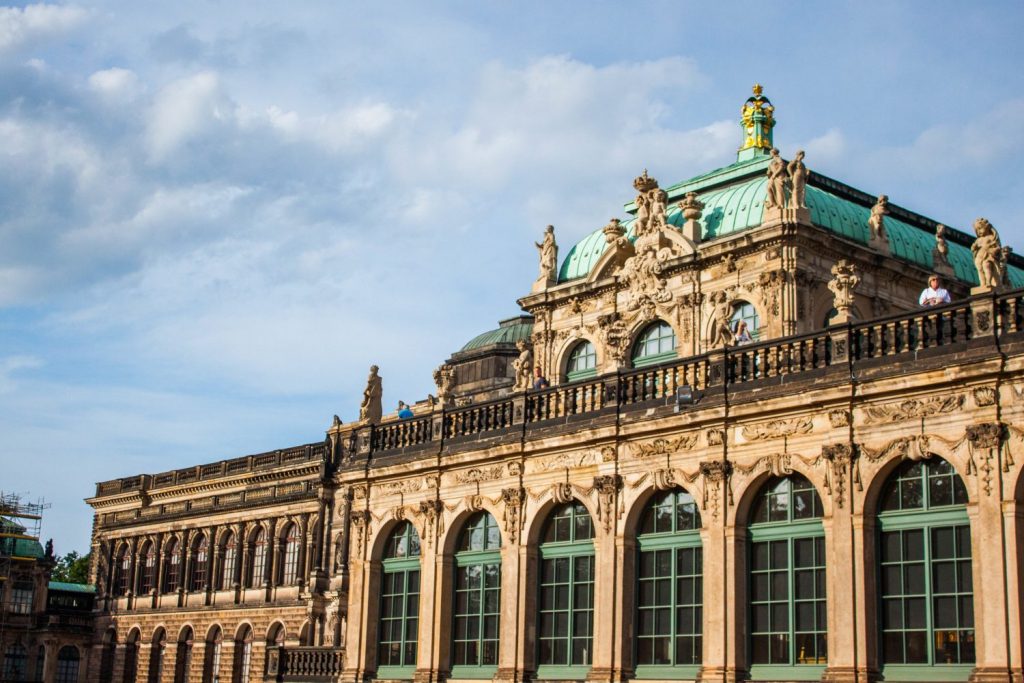
Glockenspiel Pavilion
The Glockenspiel Pavilion southeast of the Zwinger is topped by a sculpture of Hercules. Hercules, holding the globe on his shoulders, is meant to reference Augustus 1st. The Glockenspiel building features a collection of porcelain bells made by the famous Meissen porcelain factory. The carillon of bells plays a melody every 15 minutes. The songs depend on the seasons and include Vivaldi, Mozart, and Bach pieces. Meissen was a town only about 25 km from Dresden. It created some of the finest quality porcelain outside of Asia. It was the first European porcelain factory when it opened in 1710. Exit through the Glockenspiel gates to continue on tour.

Dresden Castle
As you exit the Zwinger, come into the courtyard of the Dresden Castle. The Royal Palace is one of the oldest buildings in Dresden, originally built around 1200. Additional wings were built over the years, creating an almost patchwork quilt of architectural styles from Renaissance to Baroque and Romanesque. Augustus the Strong made some of the most elaborate and impressive designs on the building’s extensions.

Inside the Castle, the courtyard displays one of the best examples of Sgraffito (decoration made by scratching through a surface to reveal a lower layer of a contrasting colour) used all over the facade. These days, the royal family no longer resides inside. Instead, the building contains a museum complex with the New Green Vault, the Numismatic Cabinet, the Collection of Prints, Drawings and Photographs and the Dresden Armory with the Turkish Chamber.

Hotel Taschenbergpalais Kempinski
Across the street from the Palace is the Hotel Taschenbergpalais Kempinski. The building was originally designed in 1705 for Augustus the Strong‘s mistress, Countess Anna Constanze von Holm. It is still a shock to imagine that right beside the royal palace is such a display of affection for the King’s mistress. The creamy yellow facade, frilly white windows and bright terracotta roof look like a beautiful dress. The hotel was levelled to ashes after WWII and rebuilt at the price of 127.8 million euros. Today the hotel is THE best to stay in Dresden for celebrities, dignitaries and even the royal family.

Procession of Princes
Walk along Taschenberg and turn north up Schloßstraße. At the end of Schloßstraße, you’ll reach the Fürstenzug or the Procession of Princes. This 101-meter-long porcelain portrait depicts the entire history of Dresden through the men who built, controlled, governed and sparked new thoughts and ideas within it. It features Dukes, Electors, Kings and other leading figures from the arts and sciences. This is the world’s largest porcelain artwork. The mural was first installed in 1871 and took more than five years to complete.

Shockingly enough, this mural withstood the great Dresden bombing of WWII. It suffered minimal damage and was a beacon of hope to the people of Dresden after the war.
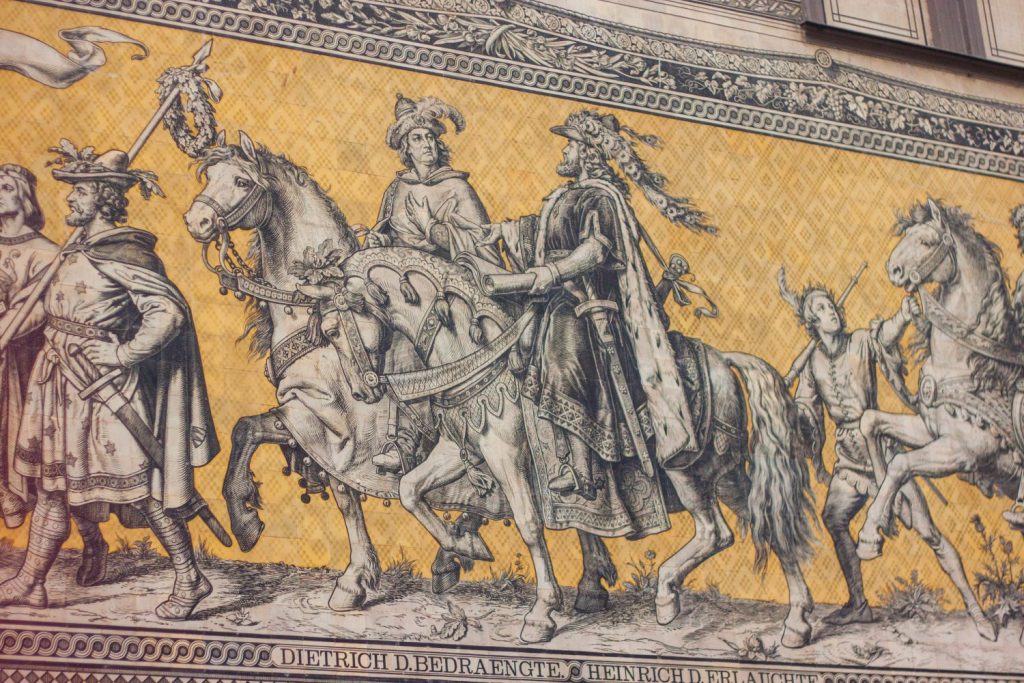
Stallhof und Langer Gang
The Stallhof und Langer Gang or Royal Stables are just down from the Procession of Princes. These stables were used as the location for horse tournaments since the 15th century. Some of the most exciting jousting activities took place here, and where the who’s who of the German elite came to be entertained. Today, the stalls are the site of the Dresden Christmas Market.

Neumarkt
Continue walking east along Augustusstraße, until you reach a large square, the Neumarkt. The Neumarkt is the cultural centre of Dresden’s historical district. The original Neumarkt was designed in the German Baroque style. Baroque designs loved pastel colours, not just on their frescos, but everywhere they could put them.

The Neumarkt is a very touristy place, but there are still some great, unique places to eat. Don’t be fooled by the touristy gimmicks, stick to something traditional. Something that’s been standing in the same spot, serving up food as it would hundreds of years before. Avoid the “Canadian Steakhouses” and Italian gelato shops.
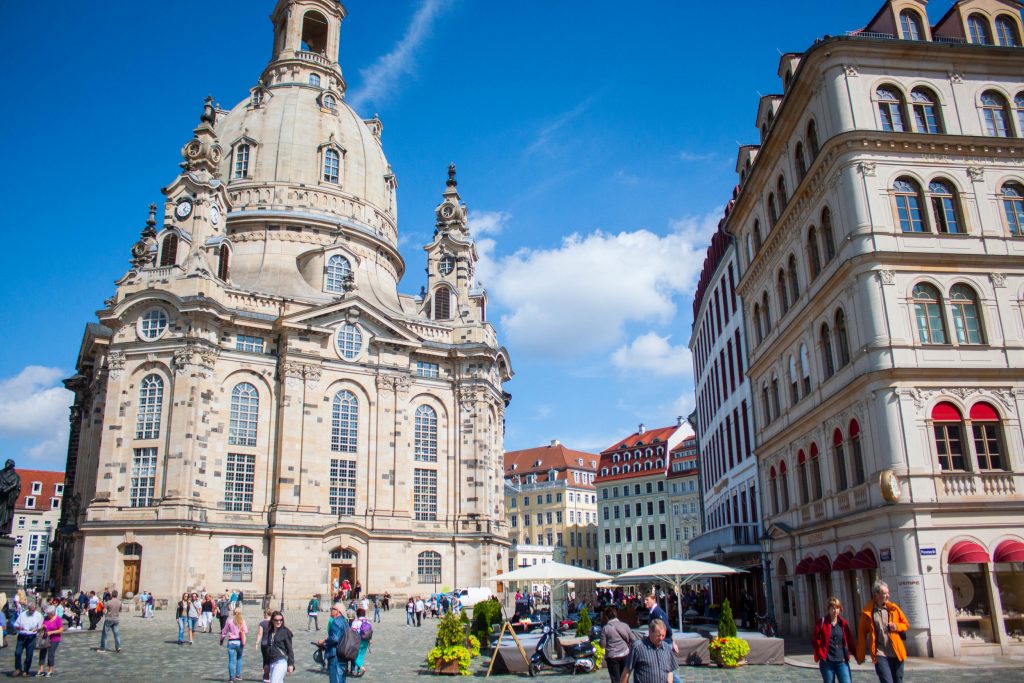
Dresden Frauenkirche
For our final stop on tour, we are heading inside the Dresden Frauenkirche. We are going inside here, and one of the best aerial views of Dresden is from the top of the church. The Dresden Frauenkirche, or Church of Our Lady, is one of Europe’s grandest buildings.

During WWII, the church was heavily bombed. On February 13th, 1945, the American and British forces dropped thousands of bombs on Dresden. The church had withstood bombings and attacks before, but never to this extent. After the war, people collected pieces of the destroyed church in the hopes that the former heart of the city would be rebuilt one day. In 1989, a 14-member group of enthusiasts headed by Ludwig Güttler, a noted Dresden musician, formed a Citizens’ Initiative to raise money for the restoration. In the end, rebuilding the church cost €180 million, most of which was raised by private citizens.
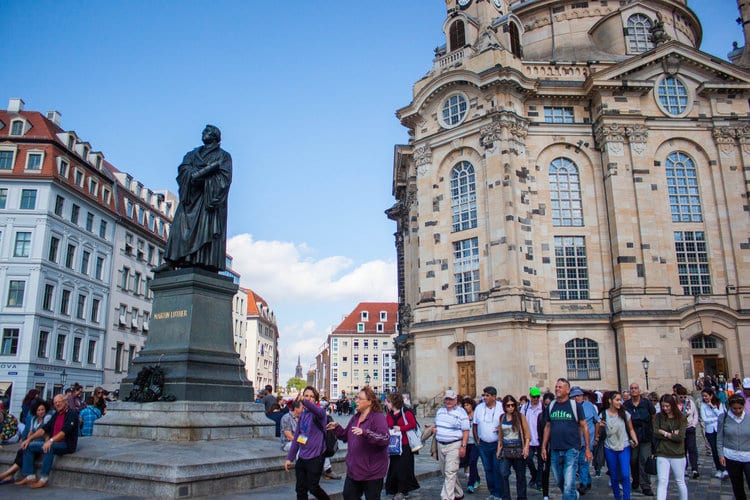
Memorial to the old Church
Outside the church’s front doors lies an original piece of the dome, blackened from the explosion as a memorial to the original church and those who died trying to protect it. To this day, you can stand outside the church and see the original pieces of stone used in the church’s restoration. The fire and weathering cover these stones with a darker patina. But in a few hundred years, the remaining pieces of sandstone will also become weathered and blend into the original stones. It was a sight to see as it is, making out the immensity of stones salvaged by everyday citizens.

Church Interior
The original Baroque Church was built between 1726 and 1743 by Dresden’s city architect, George Bähr. The church’s interior is bright and covered from head to toe in pastel colours. When restoring the church, artists used paintings and photographs of the original colours to restore it to its former brilliance. Bähr especially loved green and gold and accented the church with these trimmings. The windows are made of clear glass. Although this might look like an oversight or work in progress from the restoration, it is actually on purpose. The architect wanted the pure sunlight to filter through the windows, unheeded by stained glass, to illuminate the inside of the church.

View from the Tower
The winding staircase leads you to a tiny trapdoor which you climb through to suddenly come through to a viewing platform with a stunning view of the city. From here, you have a 360° view across the Elbe and the city of Dresden. On a clear day, you can see past the city and the countryside surrounding it.

You can see the newly restored square and all the little dots of people below. During the restoration and after the war, this square was where they stored thousands of rubble. Now that the construction is done, the square has opened back up to the public – and they have greatly enjoyed having it back. As well as their stunning church which anchors the centre of the city.

From here, we end our tour. Dresden is truly a city of magnificent resurgence. Exploring it on foot is the perfect way to get in touch with so many different aspects of the old, the new and the restored.
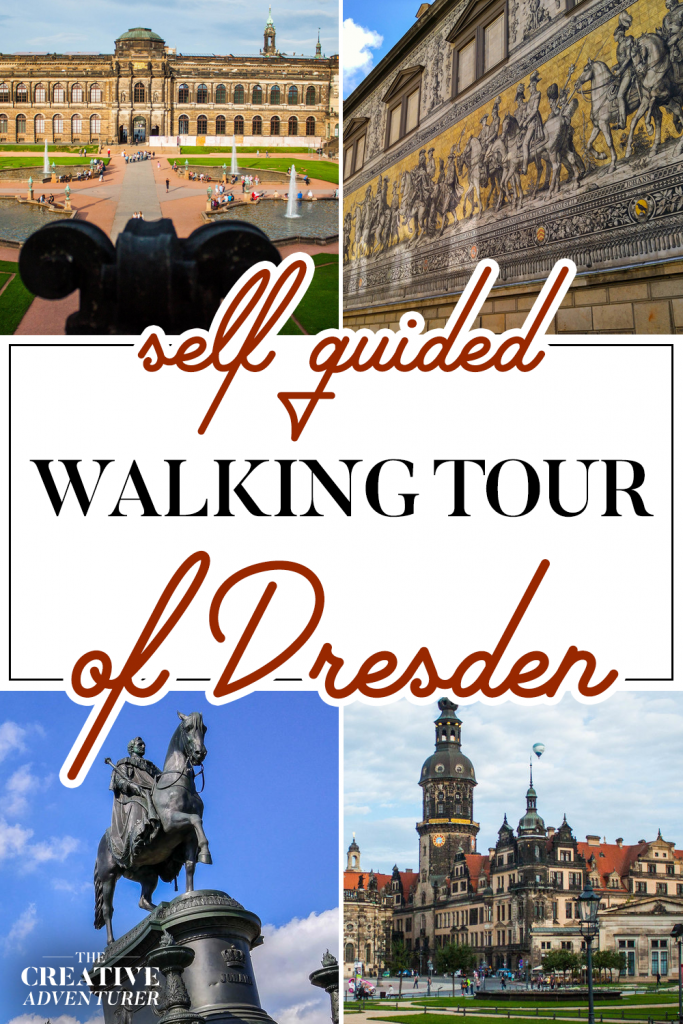






1 COMMENT
axelssonfridaa@gmail.com
6 years agoSie brauchen ein Darlehen, aber Sie werden von der Bank oder Finanzinstitutionen abgelehnt, die Sie in unveränderlichen Bedingungen an Ihr monatliches Einkommen, exorbitante Zinsen, bindet. Sie möchten ein Darlehen haben, um Ihre Bedürfnisse zu erfüllen. Kein Problem. Was auch immer Ihre finanzielle Situation ist, ich biete Ihnen Hypotheken, kommerzielle Kredite, internationale Kredite, persönliche Darlehen, exklusive Kredite und Bildungskredite. Ich biete Kredite an Partnerschaften an. Du bist wirklich in Not, also kontaktiere mich. E-Mail: (angelaleblan@gmail.com)
whatsapp: +33756843707